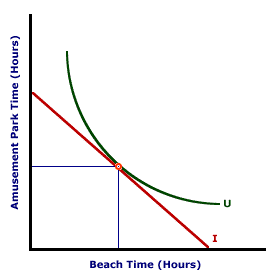
|
|
AD VALOREM TARIFF: A tax on imports that is specified as a percentage of the value of the good or service being taxed. This is one form of trade barrier that's intended to restrict imports into a country. Unlike nontariff barriers and quotas, which increase prices and thus revenue received by domestic producers, an 'ad valorem tariff' generates revenue for the government. For example: a 15 percent ad valorem tariff on a TV set worth $100 would pay a tariff of $15. One advantage of an ad valorem tariff is that it keeps up with changes in prices (mostly inflation).
Visit the GLOSS*arama
|
|


|

|
                           CONSTRAINED UTILITY MAXIMIZATION: The process of obtaining the highest possible level of utility from the consumption of goods or services, under given restrictions, when the highest overall level of utility cannot be reached. The notion of constrained utility maximization is a modification of the more general utility maximization assumption. It is based on the recognition that consumers might be restricted from achieving the absolute maximum level of utility. The primary restrictions tend to be the amount of income available relative to price paid. Constrained utility maximization generally does reach the peak of the total utility curve. While the generic notion of utility maximization as the unrestricted pursuit of utility is important to the study of economics and consumer demand theory, everyday life is primarily guided by the notion of constrained utility maximization. People seldom maximize utility outright. They must do the best they can under assorted constraints and restrictions.Utility Analysis| Roller Coaster Utility |  |
The accompanying table can be used to illustrate constrained utility maximization. The numbers indicate the total utility obtained by Edgar Millbottom while riding the Monster Loop Death Plunge roller coaster at the Shady Valley Amusement Park. The right-hand column indicates the accumulated satisfaction Edgar receives from riding the Monster Loop Death Plunge roller coaster 8 times during his day at the amusement park.While unrestricted utility maximization would see Edgar ride the roller coaster 6 times and receive 36 utils of satisfaction, assorted constraints might prevent him from doing so. Consider a few examples: - Maybe the lines are so long that he can squeeze in ONLY 4 rides during his day at the amusement park.
- Maybe several of his closest friends lock him in one of the restroom stalls for several hours, thus preventing him from even reaching the roller coaster.
- Maybe an earthquake shakes the Monster Loop Death Plunge roller coaster into a pile of splintered rumble after his second ride.
- Or more relevant to the study of demand, maybe the amusement park charges a $1 per ride and Edgar has only $4 dollars to spend.
For the last example, the best that Edgar can do is 4 trips around the coaster track. His constrained utility maximization is only at 32 utils rather than 36 utils. Income and prices inevitably impose constraints on the utility generated from consumption.Indifference Curve Analysis| Two Goods |  |
Constrained utility maximization can be incorporated quite easily in standard utility analysis. However, it is even more important to indifference curve analysis.The standard diagram used for indifference curve analysis is presented in the exhibit to the right. The indifference curve, labeled U, presents all combinations of two goods that provide the same amount of utility. The income or budget constraint, labeled I, shows the alternative combinations of the two goods that the buyer can purchase given a specific amount of income and existing prices. In this analysis, the consumer maximizes utility by reaching the indifference curve corresponding to the highest possible level of utility, given the existence of the budget constraint. This is achieved at a point of tangency, that is, where the budget constraint just touches the indifference curve a single point.

Recommended Citation:CONSTRAINED UTILITY MAXIMIZATION, AmosWEB Encyclonomic WEB*pedia, http://www.AmosWEB.com, AmosWEB LLC, 2000-2024. [Accessed: May 18, 2024].
Check Out These Related Terms... | | | | |
Or For A Little Background... | | | | | |
And For Further Study... | | | | | | | | | | | | | |
Search Again?
Back to the WEB*pedia
|



|

|
GREEN LOGIGUIN
[What's This?]
Today, you are likely to spend a great deal of time flipping through mail order catalogs wanting to buy either super soft, super cuddly, stuffed animals or a large stuffed brown and white teddy bear. Be on the lookout for the happiest person in the room.
Your Complete Scope
This isn't me! What am I?
|

|
|
Al Capone's business card said he was a used furniture dealer.
|

|
|
"Perhaps the most valuable result of all education is the ability to make yourself do the thing you have to do, when it ought to be done, whether you like it or not; it is the first lesson that ought to be learned; and however early a man's training begins, it is probably the last lesson that he learns thoroughly. " -- Thomas H. Huxley, Scientist
|

|
CAR
Cumulative Average Return
|

|
|
Tell us what you think about AmosWEB. Like what you see? Have suggestions for improvements? Let us know. Click the User Feedback link.
User Feedback
|


|


